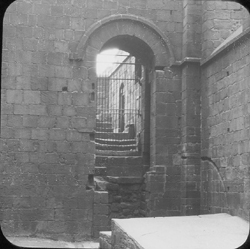|
|
You are here:

The dormitory
The monks’ dormitory at Kirkstall extended
over fifty metres and could have accommodated some 80-100 monks.
It was situated on the first floor and accessed during the day by
a staircase from the cloister; a second stairway connected the dormitory
to the church and was used by the monks when they rose during the
night to celebrate Vigils
in the choir. The dormitory was originally covered by a high-pitched
timber roof which was later replaced by one of a lower pitch.(1)
A series of windows on either side provided light during the day;
one or two lanterns also burned at all times to prevent misconduct.
These lanterns were placed in such a way that they illuminated the
reredorters, the monks’ latrine block, which was situated at
the far end of the dormitory.(2)
A Cistercian cure for insomnia:
Look at your coarse woollen
blanket and bedcovers and compare your bed to the grave,
just as if you were entering it for
burial … If you can sleep, all is well; if you cannot,
experience has proved that if you say the Athanasian Creed
seven times or the Seven Penitential Psalms, you will fall
asleep.
[Stephen of Sawley, ‘Mirror for Novices’ ,
ch. 20 (p. 112)].
|
In accordance with chapter 22 of the Rule
of St Benedict the monks slept fully clothed ‘as if to
prepare for the Lord’. This was in part for reasons of modesty
but also meant that when the bell for night Vigils sounded the monks
did not have to waste time dressing but could simply climb out of
bed and make their way to the choir stalls in the church. The monks
lay on mattresses filled with straw, which were arranged around
the room; there would have been a closet of sorts in the centre.
Bedclothes were to be either black or white and pillows of a moderate
size. At first all the monks slept in the dormitory, but the abbot
later moved to his own lodgings. The sacrist
of Kirkstall may have occupied the small chamber that adjoined the
dormitory, so that he could rise before the others to sound the
bell for Vigils and keep an eye on the goings on in church. In the
fourteenth century the General
Chapter conceded that priors and sub-priors might construct
cells within the dormitory – rooms furnished with a lock -
to give them greater privacy, and it is likely that at this time
the other monks had some kind of a partition or screen to provide
some seclusion.
The monks were to observe the strictest silence
in the dormitory at all times, and even sign language was forbidden
here.
<back><new section>
|







